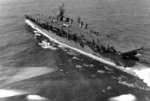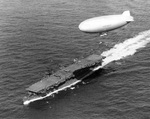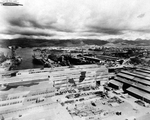Langley (Independence-class)
| Country | United States |
| Ship Class | Independence-class Light Carrier |
| Hull Number | CVL-27 |
| Builder | New York Shipbuilding Corporation, Camden, New Jersey, United States |
| Laid Down | 11 Apr 1942 |
| Launched | 22 May 1943 |
| Commissioned | 31 Aug 1943 |
| Decommissioned | 11 Feb 1947 |
| Displacement | 11,000 tons full |
| Length | 623 feet |
| Beam | 109 feet |
| Draft | 26 feet |
| Machinery | General Electric geared turbines with four screws |
| Power Output | 100,000 shaft horsepower |
| Speed | 31 knots |
| Crew | 1,569 |
| Armament | 24x40mm guns, 22x20mm anti-aircraft guns |
| Armor | 5in belt, 2in deck, 0.5in conning tower |
| Aircraft | 45 |
| Transferred to France | 8 Jan 1951 |
| Transferred Back to US | 20 Mar 1963 |
Contributor: C. Peter Chen
ww2dbaseNamed after the first United States Navy carrier which was sunk near the start of the Pacific War, the second USS Langley, CVL-27, was commissioned into service in Aug 1943. She had originally been ordered as a light cruiser, but she was reordered as a light carrier in Mar 1942 and was renamed Langley in Nov 1942. She joined the war starting in early 1944 and saw action in the Marshall Islands, New Guinea, Mariana Islands, Palau Islands, Taiwan, Ryukyu Islands, Iwo Jima, Okinawa, and other locations as the Japanese front lines slowly fell back toward the Japanese home islands. She returned to the United States for a scheduled overhaul in Jun 1945, and while en route back to the front, Japan announced its intention to surrender. After transporting Pacific War veterans back to the United States in Oct 1945, she conducted a similar mission with European War veterans between Nov 1945 and Jan 1946. She was inactivated at Philadelphia, Pennsylvania, United States in 1946 and was decommissioned, also at Philadelphia, in the following year.
ww2dbaseIn 1951, Langley was transferred to the French Navy under the Mutual Defense Assistance Program where she would be renamed La Fayette (R96). Based out of Toulon, France, she made several journeys to the Far East with American-built WW2-era propeller carrier aircraft, seeing action in Indochina. She also saw service in the Mediterranean Sea and in the Atlantic Ocean, where she participated in the 1956 Suez Crisis and assisted survivors of the earthquake of 1960 at Agadir, Morocco, among other missions. La Fayette was returned to the United States in Mar 1963 after logging 350,000 nautical miles, and was sold for scrap at Baltimore, Maryland, United States in 1964.
ww2dbaseSource: Wikipedia
Last Major Revision: May 2012
Light Carrier Langley (Independence-class) (CVL-27) Interactive Map
Photographs
 |  |  |  |
Langley (Independence-class) Operational Timeline
| 31 Mar 1942 | Light cruiser Fargo, previously ordered but not yet laid down, was reordered by the US Navy as a carrier to be named Crown Point. |
| 11 Apr 1942 | The keel of carrier Crown Point was laid down by the New York Shipbuilding Corporation in Camden, New Jersey, United States. |
| 13 Nov 1942 | Carrier Crown Point, still under construction at Camden, New Jersey, United States, was renamed Langley. |
| 22 May 1943 | Carrier Langley was launched at Camden, New Jersey, United States. |
| 15 Jul 1943 | The US Navy established a new scheme for the designation of aircraft carriers. Large fleet carriers would retain the designation of CV. 10,000-ton carriers built on light cruiser hulls were changed from CV to CVL (light carriers). Auxiliary aircraft carriers, previously ACV, were redesignated as CVE (escort carriers). Finally, the new designation of CVB (large carriers) was established for the Midway-class carriers. |
| 31 Aug 1943 | USS Langley was commissioned into service. |
| 12 Oct 1944 | VT-44 squadron TBM aircraft from USS Langley attacked Kagi Airfield in Kagi (now Chiayi), Taiwan. |
| 18 Dec 1944 | Many ships from the United States Third Fleet, Task Force 38 sailed into Typhoon Cobra in the Philippine Sea. Three destroyers and 790 men were lost. |
| 3 Jan 1945 | 6 TBM-1C aircraft and 12 F6F-5 fighters, both of Air Group 44 from USS Langley, attacked Hokuto Airfield (referred by the Americans as "Keishu Airfield") in Hokuto (now Beidou) in central Taiwan with 60 100-pound bombs, rockets, and strafing. No Japanese aircraft rose to defend. |
| 14 Mar 1945 | USS Yorktown (Essex-class), USS Enterprise, USS Intrepid, USS Langley (Independence-class), USS Flint, USS San Diego, and USS St. Louis departed Ulithi, Caroline Islands to resume raids on Japan in support of the Okinawa operations. |
| 18 Mar 1945 | USS Yorktown (Essex-class), USS Enterprise, USS Intrepid, USS Langley (Independence-class), USS Flint, USS San Diego, and USS St. Louis arrived in the operating area off Japan and began launching strikes on airfields on Kyushu, Honshu, and Shikoku. The task group came under air attack almost as soon as operations began. Yorktown and Enterprise were struck by single bombs that resulted in minimal casualties and minimal damage. |
| 19 Mar 1945 | USS Yorktown (Essex-class), USS Enterprise, USS Intrepid, USS Langley (Independence-class), USS Flint, USS San Diego, and USS St. Louis continued air operations against the three southernmost islands of Japan. |
| 11 Feb 1947 | USS Langley was decommissioned from service at Philadelphia, Pennsylvania, United States. |
| 8 Jan 1951 | US light carrier Langley was transferred to France. |
| 2 Jun 1951 | Light carrier La Fayette (R96) was commissioned into service. |
| 20 Mar 1963 | French light carrier La Fayette was transferred to the United States. |
Did you enjoy this article or find this article helpful? If so, please consider supporting us on Patreon. Even $1 per month will go a long way! Thank you. Share this article with your friends: Stay updated with WW2DB: |
» Mariana Islands Campaign and the Great Turkey Shoot
» Typhoon Cobra
» Raid into the South China Sea
» Battle of Iwo Jima
» Okinawa Campaign
Document(s):
» US Aircraft Carrier Functions
» US Aircraft Carrier Operational Status By Month
» US Carrier Time Operational
 |
- » 1,150 biographies
- » 337 events
- » 43,917 timeline entries
- » 1,241 ships
- » 350 aircraft models
- » 207 vehicle models
- » 374 weapon models
- » 123 historical documents
- » 260 facilities
- » 470 book reviews
- » 28,541 photos
- » 432 maps
Winston Churchill
Please consider supporting us on Patreon. Even $1 a month will go a long way. Thank you!
Or, please support us by purchasing some WW2DB merchandise at TeeSpring, Thank you!